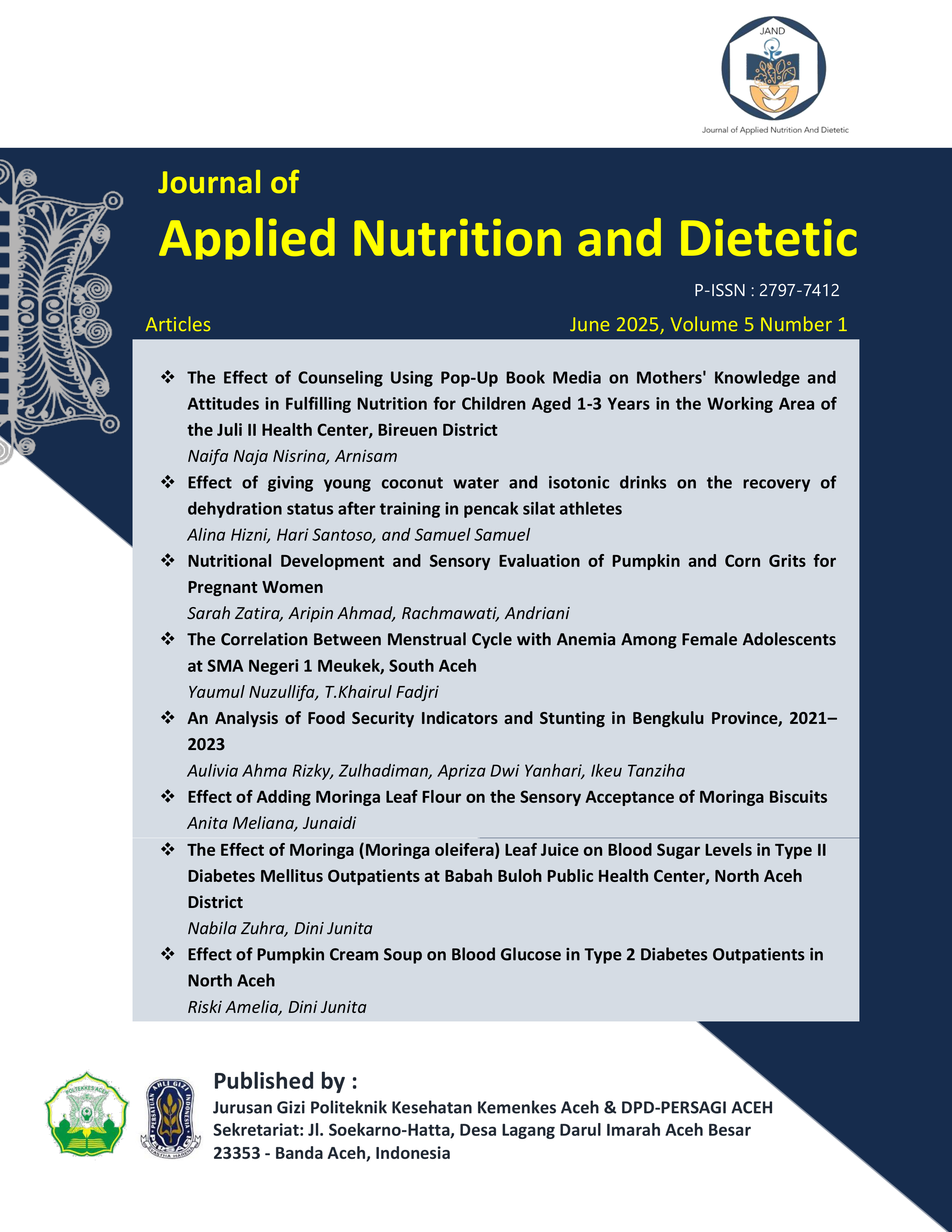Effect of giving young coconut water and isotonic drinks on the recovery of dehydration status after training in pencak silat athletes
DOI:
https://doi.org/10.30867/jand.v5i1.351Kata Kunci:
coconut water, electrolyte balance, hydration status, isotonic beverage, urine pHAbstrak
This study evaluates the effectiveness of different types of post-exercise drinks on rehydration in pencak silat athletes. Prolonged exercise in hot environments leads to physiological changes due to depleted glycogen stores and fluid-electrolyte loss through sweat. The aim of this study was to analyze the average difference between the effects of young coconut water (Cocos nucifera) and commercial isotonic drinks on the rehydration process. This experimental research involved dividing subjects into two treatment groups: Group 1 received young coconut water, while Group 2 received a commercially available isotonic drink. Dehydration status was assessed through measurements of body weight, urine pH, and urine specific gravity. Paired t-tests were used to analyze within-group differences before and after treatment, while unpaired t-tests compared differences between groups. The average fluid intake for rehydration was 1062.5 ml. Fluid administration had a significant effect on dehydration status (p < 0.05). A significant increase in urine pH was observed: 1.63 for coconut water and 0.97 for isotonic drinks. These results indicate a difference in the effectiveness of coconut water and isotonic drinks on hydration recovery.
Referensi
Adams, J. D., Kavouras, S. A., Robillard, J. I., Bardis, C. N., Johnson, E. C., Ganio, M. S., & White, M. A. (2016). Fluid balance of adolescent swimmers during training. The Journal of Strength & Conditioning Research, 30(3), 621-625.
Altavilla, C., Rossetti, G., & PÉREZ, P. C. (2019). Fluid balance in young swimmers: could the different color of drinking bottles change water intake during swimming practice?. Medicina Dello Sport, 72(1), 1.
Altavilla, Cesare, Soledad Prats Moya, and Pablo Caballero. (2017). Hydration and nutrition knowledge in adolescent swimmers. Does water intake affect urine hydration markers after swimming?.
Amendola C., Iannilli I., Restuccia D., Santini I., Vinci G. 2004. Multivariate statistical analysis comparing sport and energy drinks. Innovative Food Sciences & Emerging Technologies, 5: 263-267.
Burke, L. M., Cox, G. R., Cummings, N. K., & Desbrow, B. (2001). Guidelines for daily carbohydrate intake. Sports medicine, 31(4), 267-299.
Dien Gristyutawati, A. (2012). Students perceptions of pencak silat as a national cultural heritage in Semarang city in 2012. ACTIVE: Journal of Physical Education, Sport,Health and Recreation, 1(3).
Dubnov-Raz, G., Lahav, Y., & Constantini, N. W. (2011). Non-nutrients in sports nutrition: Fluids, electrolytes, and ergogenic aids. e-SPEN, the European e-Journal of Clinical Nutrition and Metabolism, 6(4), e217-e222.
Dubnov-Raz, G., Lahav, Y., & Constantini, N. W. (2011). Non-nutrients in sports nutrition: Fluids, electrolytes, and ergogenic aids. e-SPEN, the European e-Journal of Clinical Nutrition and Metabolism, 6(4), e217-e222.
E. C.(2020). Impact of Nutrient Intake on Hydration Biomarkers Following Exercise and Rehydration Using a Clustering-Based Approach. Nutrients, 12(5), 1276.
Endre Z.H, Sports Nutrition, Textbook of Nutritional Science, EGC Medical Book Publisher 2014;119.
Ersoy N, Ersoy G: Sports drinks for hydration and alter native drinks review. Turkiye Klini kleriJ Spor ts Sci, 2013, 5: 96-100.
Ghasemi, F., Mohebbi, H., & Arazi, H. (2020). The Effect of Drinking Skim Milk, Soy Milk and Water on Rehydration and Exercise Performance in Young Trained Females. Sport Physiology, 12(45), 45-60.
Halim, H. H., Dek, M. S. P., Hamid, A. A., & Jaafar, A. H. (2017). Fatigue onset through oxidative stress, dehydration and lactic acid accumulation and its in vivo study using experimental animals. Journal of Advanced Review on Scientific Research, 35(1), 1-12.
Ihsan, N., & Suwirman, S. (2018). Contribution of Concentration to Kick Speed in Pencak Silat.
Ilmiyah, V. A., & Kurniawati, R. (2020). The Relationship Between Knowledge of the Benefits of Water with Water Consumption Behavior. Alkautsar Scientific Journal of Nursing and Health (JIKKA), 1(1).
Indonesian Sports Science Media, 8(1), 1-6.
Kitson, O. (2020). Sensory perception of an oral rehydration solution throughout exercise in the heat: a thesis presented in partial fulfillment of the requirements for the degree of Masters of Science in Nutrition and Dietetics at Massey University, Albany, New Zealand (Doctoral dissertation,Massey University).
Kitson, O., Rutherfurd-Markwick, K., Foskett, A., Lee, J. K. W., Diako, C., Wong, M., & Ali, A. (2021). Sensory Perception of an Oral Rehydration Solution during Exercise in the Heat. Nutrients,13(10), 3313.
Mardianto, E., & Zulman, Z. (2019). Review of Physical Condition of MAN 3 Padang Pencak Silat Athletes. JPDO Journal, 2(4), 11-17.
Moreno, I. L., Pastre, C. M., Ferreira, C., de Abreu, L. C., Valenti, V. E., & Vanderlei, L. C. M. (2013). Effects of an isotonic beverage on autonomic regulation during and after exercise. Journal of the International Society of Sports Nutrition, 10(1), 2.
Muñoz, C. X., Johnson, E. C., Kunces, L. J., McKenzie, A. L., Wininger, M., Butts, C. L., & Lee,
Penggalih, M.H.S.T, Pratiwi D, Solichah KM, et al, Anthropometric measurements in athletes, Energy Systems. Anthropometry, and athlete food intake, publisher Gajah Mada University Press, 2019; 97-113.
Reddy, P. and Lakshmi, M. Coconut water properties, uses, and nutritional benefits in health and disease review, Journal of current clinical medicine and laboratory biochemistry, 10(2), 2003, 11-21.
Rohman, U., & Effendi, M. Y. (2019). Physical Condition Profile of PPLP Pencak Silat Athletes in East Java. Journal Physical Education, Health and Recreation, 3(2), 112-121.
Saat, M., Singh, R., Sirisinghe, R. G., & Nawawi, M. (2002). Rehydration after exercise with fresh young coconut water, carbohydrate-electrolyte beverage and plain water. Journal of physiological anthropology and applied human science, 21(2), 93-104.
Scrivin, R., & Black, K. (2018). Sports Drinks Consumed During Exercise, Which Affect Thermoregulation and/or Athletic Performance in the Heat: A Review. Strength & Conditioning Journal, 40(5), 108-119.
Stasiuk, E., & Przybyłowski, P. (2017). Osmolality of isotonic drinks in the aspect of their authenticity. Polish Journal of Natural Sciences, 32(1), 161-168.
Sudarsono, E. S., Nurohmi, S., Damayanti, A. Y., & Sari, D. D. (2019). Relationship between the level of knowledge about hydration and total fluid intake in adolescent girls. Darussalam Nutrition Journal, 3(2), 50-54.
Ulvie, Y. N. S., Kusuma, H. S., & Agusty, R. (2017). Identification of Water Consumption Level and Dehydration Status of Pencak Silat Tapak Suci Putra Muhammadiyah Semarang Athletes. Indonesian Sports Science Media, 7(2), 48-51.
Wisniewski, A. (2018). The Effect of Oral Rehydration Solutions (Sports Drinks) on Strength, Speed, andEndurance: A Field Study.
Unduhan
Diterbitkan
Cara Mengutip
Terbitan
Bagian
Lisensi
Hak Cipta (c) 2025 JAND: Journal of Applied Nutrition and Dietetic

Artikel ini berlisensiCreative Commons Attribution-ShareAlike 4.0 International License.











